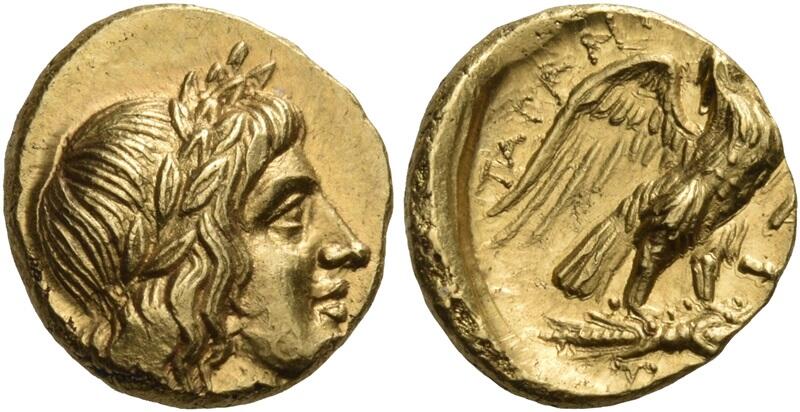Taras, gold, triobols (276-272 BCE)
From SILVER
276 BCE - 272 BCE Gold 4,377 kg
Description
| ObverseInscription or printing placed on the obverse.: | Head of Apollo right, wearing laurel wreath. (In field, NK). |
| ReverseInscription or printing placed on the reverse.: | (TAPANTINΩN ou AΠOΛ) (Greek).Eagle with spread wings standing right on thunderbolt, below right wing, monogram of AP over spear head slanting downwards to right |
Mint and issuing power
| MintIdentifies the place of manufacture or issue of a numismatic object.: | Taras | Ancient regionAncient region.: | Calabria | Modern countryModern country: Italy | AuthorityIdentifies the issuing power. The authority can be "pretended" when the name or the portrait of X is on the coin but he/she was not the issuing power. It can also be "uncertain" when there is no mention of X on the coin but he/she was the issuing power according to the historical sources: |
Chronology
| FromIdentifies the initial date in a range assigned in a numismatic context. | 276 BCE | toIdentifies the final date in a range assigned in a numismatic context.. | 272 BCE | PeriodTime period of the numismatic object.: Hellenistic 323-30 BC |
Physical description
| MetalThe physical material (usually metal) from which an object is made.: | Gold |
Median weightMedian of the weights of numismatic objects (in grams). in grams | 2.15 | DenominationTerm indicating the value of a numismatic object. Examples: tetradrachm, chalkous, denarius.: | triobol |
StandardStandard.: | Attic |
Image

S 847 - Taras, gold, triobol, 276-272 BC.jpg [1]
References
| Die study referencePublication of the study: | Fischer-Bossert 19991Fischer-Bossert 1999, p. 367-371, G47-63 | ||
| Coin series referenceReference to coin series study: | HN Italy2HN Italy, n° 986 | ||
| Coin series web referenceCoin series web references: | |||
Obverse dies distribution
| FrequencyFrequency of specimen in distribution. ᵖ | Number of obversesNumber of obverse dies. ᵖ (o) | % (o) | Number of coinsNumber of coins. (n) | % (n) | Die nameName(s) of the die(s). |
| 1 | 1 | 10 | 1 | 1.03 | 45;48 |
| 2 | 1 | 10 | 2 | 2.06 | 43 |
| 3 | 2 | 20 | 6 | 6.19 | 41;42 |
| 5 | 2 | 20 | 10 | 10.31 | 46;47 |
| 15 | 1 | 10 | 15 | 15.46 | 49 |
| 19 | 2 | 20 | 38 | 39.18 | 44;50 |
| 25 | 1 | 10 | 25 | 25.77 | 51 |
| Total | 10 of 10 | 100 | 97 of 97 | 100 |
Reverse dies distribution
| FrequencyFrequency of specimen in distribution. ᵖ | Number of reverse diesNumber of reverse dies. (r) | % (r) | Number of coinsNumber of coins. (n) | % (n) | Die nameName(s) of the die(s). |
| 1 | 3 | 17.65 | 3 | 3.09 | 50;53;57 |
| 2 | 2 | 11.76 | 4 | 4.12 | 49;56 |
| 3 | 3 | 17.65 | 9 | 9.28 | 47;48;55 |
| 4 | 1 | 5.88 | 4 | 4.12 | 52 |
| 5 | 2 | 11.76 | 10 | 10.31 | 54;60 |
| 6 | 1 | 5.88 | 6 | 6.19 | 61 |
| 8 | 2 | 11.76 | 16 | 16.49 | 59;62 |
| 14 | 2 | 11.76 | 28 | 28.87 | 51;58 |
| 17 | 1 | 5.88 | 17 | 17.53 | 63 |
| Total | 17 of 17 | 99.98 | 97 of 97 | 100 |
Quantification
| Number of obversesNumber of obverse dies. ᵖ (o) | 10 | Number of singletons (o1)The number of singleton coins. ᵖ | |
| Number of reverse diesNumber of reverse dies. (r) | 17 | Number of coinsNumber of coins. (n) | 97 |
| Coins per obverse dieNumber of coins per obverse die. (n/o) | 9.7 | Coins per reverse dieNumber of coins per reverse die. (n/r) | 5.71 |
| Reverse per obverse ratioRatio of obverse dies divided by reverse dies. (r/o) | 1.7 | Percentage of singletons (o1)number of coins (n) divided by the number of singletons (o1) ᵖ | % |
| Original number of dies (O) (Carter 1983 formula)The estimation of the number of coins according to Carter 1983 ᵖ | 10.18 | Coins struck if 20,000 as average productivity per dieCoins made if the average productivity for obverses (according to Carter) is 20,000. ᵖ | 203,600 |
| Original number of dies (O) (Esty 2011 formula)The estimation of the number of coins according to the singleton formula in Esty 2011 ᵖ (O) | 11.15 | Survival rate if 20,000 as average productivity per dieSurvival rate if average productivity is 20,000. ᵖ | 0.00048 |
| Coverage (o = % of O) (Esty 1984 formula)Esty 1984 - coverage (% of O) ᵖ (o = % of O) | % | Die productivity if survival rate 1/2,000Average productivity if survival rate is 1/2,000. ᵖ | 19,056.97 |
| Weight of silver (in kg) if 20,000 coins per die (O = Carter formula)Carter 1983 * Median weight * 20000 (*10 if gold or electrum) ᵖ | 4,377 kg <br /> 4,377 kg | Die productivity if survival rate 1/5,000Average productivity if survival rate is 1/5,000. ᵖ | 47,642.44 |
Remarks
Most likely one single workstation Likely military